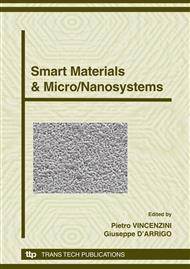p.416
p.422
p.428
p.434
p.439
p.445
p.451
p.458
p.464
Micromask Generation for Polymer Morphology Control: Nanohair Fabrication for Synthetic Dry Adhesives
Abstract:
Since early this decade, investigations into how geckos achieve their remarkable adhesive properties, have determined that multi-scale compliant systems can allow geckos to attach to nearly any surface through Van der Waals forces. Microscopic hairs on the bottom of gecko feet can make intimate contact over large areas, and allows relatively weak Van der Waals forces to produce significant adhesion on the macroscale. Over the past five years, microfabrication technology has been used to replicate these multi-scale compliant mechanisms, using silicon or polymers to reproduce microscale rods or cantilevers to produce what is known as a dry adhesive. What is more difficult is creating the nanoscale compliant systems that create most contact areas in gecko feet. This work examines how a well known problem in reactive ion etching processes, RIE "grass" can be used to great effect to alter surface morphology on the nanoscale for nearly any polymer. Identical etching parameters in the presence of different elements, like gold or aluminum, can result in radically different surface morphologies and material behaviors, potentially allowing both adhesive and non-adhesive areas to be formed in a single material. This technique is potentially the easiest and fastest way to produce nano-compliant systems for use with dry adhesives.
Info:
Periodical:
Pages:
439-444
Citation:
Online since:
September 2008
Authors:
Keywords:
Price:
Сopyright:
© 2008 Trans Tech Publications Ltd. All Rights Reserved
Share:
Citation:


